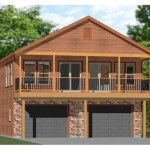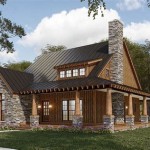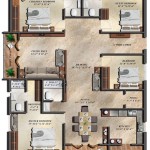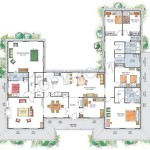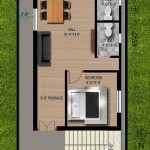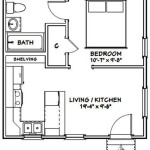Small House Plans With Basement Under 1000 Sq Ft
Affordable housing and efficient space utilization have become increasingly important considerations in modern home design. Small house plans with basements, particularly those under 1000 square feet, offer a viable solution for homeowners seeking cost-effective living spaces without sacrificing functionality or storage. This design approach maximizes the available footprint by extending the living area vertically, leveraging the potential of below-grade spaces. A well-designed basement can significantly increase the overall livable area, providing space for bedrooms, recreational rooms, home offices, or ample storage.
These smaller homes are particularly attractive alternatives in urban environments where land costs are high and building regulations may restrict horizontal expansion. The inclusion of a basement allows for a more compact above-ground structure while still meeting the needs of a modern lifestyle. Furthermore, energy efficiency can be enhanced through careful basement design, utilizing the earth's natural insulation to regulate temperature and reduce heating and cooling costs.
However, planning and constructing a small house with a basement require careful consideration of several factors, including local building codes, soil conditions, water management, and ventilation. Optimizing the layout and design is crucial to ensure the basement is a usable and comfortable extension of the home, rather than a damp or neglected space. Proper waterproofing and insulation are paramount to prevent moisture issues and maintain a healthy indoor environment. The specific use of the basement will also influence design choices, impacting the need for natural light, egress windows, and specific room layouts.
Optimizing Space in Small House Plans
Within the confines of a small house plan, every square foot must be considered. The basement offers a unique opportunity to create distinct zones within the home. By carefully planning the layout, homeowners can effectively separate living areas from sleeping quarters or storage spaces. For example, the main floor could house the kitchen, living room, and a small bathroom, while the basement could be dedicated to bedrooms, a home office, or a recreational area. This type of zoning can enhance privacy and functionality within a compact footprint.
Storage needs are often a primary concern in small homes. The basement provides an ideal space for storage, freeing up valuable square footage on the main level. Built-in shelving, custom storage solutions, and designated storage rooms can help maximize the use of the basement area. Furthermore, a well-organized basement can help reduce clutter throughout the house, creating a more spacious and inviting living environment.
The utilization of open-concept layouts on the main floor can create a sense of spaciousness in a small house. Combining the kitchen, dining, and living areas into a single, flowing space eliminates the need for dividing walls, making the home feel larger and more airy. This approach allows for natural light to penetrate deeper into the home, further enhancing the sense of openness. Carefully positioned windows and doors can also maximize natural light and create visual connections to the outside.
Furniture selection is another crucial factor in optimizing space. Multi-functional furniture, such as sofa beds, storage ottomans, and fold-away tables, can help minimize clutter and maximize the use of available space. By choosing furniture that serves multiple purposes, homeowners can create a more flexible and adaptable living environment. Wall-mounted shelving and storage units can also help free up floor space and create a more streamlined and organized look.
Basement Design Considerations
Designing a basement for a small house requires careful attention to detail to ensure it is a functional and comfortable living space. The first crucial step is addressing potential moisture issues. Proper waterproofing is essential to prevent water from seeping into the basement, which can lead to mold growth and structural damage. This includes applying a waterproof membrane to the exterior foundation walls and installing a drainage system to divert water away from the house.
Insulation is another key consideration. Insulating the basement walls and floor helps regulate temperature and prevent heat loss, making the basement a more comfortable and energy-efficient space. Rigid foam insulation is commonly used for basement walls due to its moisture resistance and high R-value. In addition to wall insulation, insulating the basement floor can also help reduce heat loss and improve comfort.
Adequate ventilation is essential to prevent moisture buildup and maintain a healthy indoor air quality. Installing a dehumidifier can help remove excess moisture from the air, preventing mold growth and creating a more comfortable living environment. Egress windows are also required in basements that are used as living spaces. These windows provide a means of escape in case of a fire and allow natural light to enter the basement. The size and placement of egress windows must comply with local building codes.
Lighting is a critical aspect of basement design. Since basements typically have limited natural light, it is important to incorporate a variety of lighting fixtures to create a well-lit and inviting space. Recessed lighting, track lighting, and wall sconces can be used to provide ambient, task, and accent lighting. Choosing light fixtures with dimmers allows for adjusting the lighting levels to suit different activities and moods.
Finishing the basement walls and floor is essential to creating a comfortable and livable space. Drywall is a common choice for basement walls, as it is relatively inexpensive and easy to install. However, it is important to use moisture-resistant drywall to prevent mold growth. For flooring, options include carpet, tile, laminate, and vinyl. Each material has its own advantages and disadvantages in terms of cost, durability, and moisture resistance. Choosing a flooring material that is suitable for basement conditions is crucial to ensure its longevity.
Integrating the Basement into the Overall House Design
A well-integrated basement seamlessly blends with the rest of the house, creating a cohesive and functional living space. The design should consider the flow of traffic between the main floor and the basement, ensuring easy access and a natural connection between the two levels. A well-placed staircase can enhance the flow and create a visual connection between the floors.
The interior design of the basement should complement the style of the main floor. Using similar colors, materials, and finishes can create a sense of continuity and harmony throughout the house. Incorporating design elements that are consistent with the overall aesthetic of the home can help create a cohesive and unified living space. For example, if the main floor has a modern design, the basement should also reflect that style.
Consider the placement of utilities and mechanical systems. Locate the furnace, water heater, and other mechanical equipment in an area that is easily accessible for maintenance and repairs, but also minimizes noise and disruption to the living areas. Soundproofing measures can be implemented to reduce noise transmission from the mechanical room to the rest of the basement. Proper planning of the utilities can also help maximize the usable space in the basement.
The use of technology can enhance the functionality and comfort of the basement. Installing a smart home system can allow for remote control of lighting, temperature, and security. Home theater systems can transform the basement into a dedicated entertainment space. The integration of technology can create a modern and convenient living environment.
Landscaping around the house can also contribute to the overall design and functionality of the basement. Proper grading and drainage can help prevent water from entering the basement. Planting trees and shrubs around the foundation can help insulate the basement and regulate temperature. Creating a patio or deck outside the basement entrance can provide an outdoor living space and enhance the connection between the indoor and outdoor areas.
Ultimately, the key to designing a successful small house plan with a basement under 1000 square feet is careful planning, attention to detail, and a focus on maximizing functionality and comfort. By considering these factors, homeowners can create a cost-effective and efficient living space that meets their specific needs and lifestyle.

7 Ideal Small Houses Floor Plans Under 1000 Square Feet

House Plans Under 1000 Square Feet Small Tiny

Tiny House Plans And Small 1 Story Below 1000 Sq Ft

Our Top 1 000 Sq Ft House Plans Houseplans Blog Com

Our Top 1 000 Sq Ft House Plans Houseplans Blog Com

Traditional Style House Plan 2 Beds Baths 1000 Sq Ft 18 1040 Small Floor Plans Cottage

Best Ing House Plans 1000 To 1499 Square Feet

Small House Plan Examples

House And Cottage Plans 1000 To 1199 Sq Ft Drummond

Tiny House Plans Floor Blueprints Designs The Designers
Related Posts

